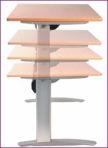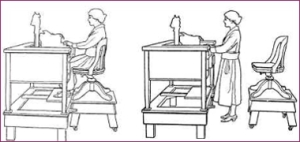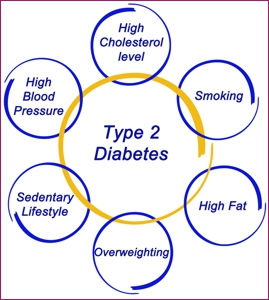(Part 1 of this blog can be found here).
Sit-stand or sit-sit, electronic, gas-lift or crank – what are the options?
 Height adjustment for true sit-stand desks is usually electronic.
Height adjustment for true sit-stand desks is usually electronic.
There are also a few models with gas-strut-supported adjustability rather than an electric motor. These models have the advantage of not requiring electricity so they can be ideal for touch-down areas or some hot-desking environments. However, the gas-lift mechanism will be weight-sensitive so it is important to ensure the proper configuration when specifying.
By contrast, the majority of electronic sit-stand desks will have a weight limit comfortably above normal requirements (as long as sitting on the desk whilst raising it is not considered a “normal requirement”!). Electronic adjustment is therefore the norm for sit-stand.
Manual adjustment by crank handle is another option to be aware of. Whilst some crank-adjustable desks may be marketed as sit-stand (and offer suitable height range), the length of time (and effort) required to make the manual adjustment will quickly deter users from actually doing so. Crank-adjustable models (typically around 650mm – 850mm height range) are normally regarded as “sit-sit” products for use in hot desk environments and areas where users of different heights need to share sitting workstations.
 The EU standard height adjustability range to qualify as a sit-stand product is 650-1250mm. The (US) ANSI/BIFMA standard is 22 – 48 inches.
The EU standard height adjustability range to qualify as a sit-stand product is 650-1250mm. The (US) ANSI/BIFMA standard is 22 – 48 inches.
Whilst many employers will want to “go by the book” and only purchase products that meet the appropriate standard, these models require triple (or two stage) telescopic legs. Versions with only two element (single stage) legs are (inevitably) cheaper and will suit a high proportion of people. They are widely used in single installations for individuals with back problems, even though they do not meet a standard.
Adapting an existing sitting desk
 A number of manufacturers have introduced products to convert a standard, sitting desk to something that can be used as a sit-stand workstation. These vary in complexity, usability and ugliness! Typically, they are either a device that sits on top of the desk or something that resembles a giant monitor arm. The choice of readily available models in the US is significantly wider than in Europe.
A number of manufacturers have introduced products to convert a standard, sitting desk to something that can be used as a sit-stand workstation. These vary in complexity, usability and ugliness! Typically, they are either a device that sits on top of the desk or something that resembles a giant monitor arm. The choice of readily available models in the US is significantly wider than in Europe.
Where cost is the most compelling issue, many employers consider such adaptors instead of complete desks. However, our own experience is that some of these adaptors turn a perfectly-good sitting desk into a not-very-good sitting desk and a not-very-good standing desk! Some models provide good ergonomics in only one posture (sitting or standing) and a compromised setup in the other. Despite assessing many variants, the portfolio of such products that we actually sell is very small.
The monitor arm variant creates substantial leverage on the desk so a very sturdy work surface is essential. Another issue to consider is stability in the standing posture. Finally, it is also important to remember that the US market uses keyboard trays extensively so users are better disposed to this type of arrangement than Europeans, who are used to operating their keyboard and mouse on the actual desk, rather than on an attachment.
One cost-effective solution without compromise is to use the top from an existing sitting desk and simply fit it to a height-adjustable frame. This not only saves money but also enables the replacement desk arrangement to blend better cosmetically with other furniture.
Treadmill & cycle desks
These are not actually sit-stand products but they have appeared in response to the health concerns already outlined in the first part of this blog. It is, therefore, probably appropriate to mention them in passing. However, I have already expressed my views on this topic so will not repeat myself.
What else should I be thinking about?
Saddle seats and perching stools
 A growing number of users are finding that saddle seats and perching stools can provide a good “half-way house” between traditional sitting and standing. However, this is a whole topic in itself and this blog series is probably already too long! If you wish to explore this concept, ensure you work with a supplier with a good understanding of sit-stand furniture and broad range of alternative seating products so that you can compare the different designs and features.
A growing number of users are finding that saddle seats and perching stools can provide a good “half-way house” between traditional sitting and standing. However, this is a whole topic in itself and this blog series is probably already too long! If you wish to explore this concept, ensure you work with a supplier with a good understanding of sit-stand furniture and broad range of alternative seating products so that you can compare the different designs and features.
Product trials are essential since saddle seats, in particular, will elicit very different (and sometimes unpredictable) responses from your user population.
Beware of the doomsayers!
There is no doubt that we sit too much and we need to take action about it. Sit-stand desks are an excellent tool in our armoury of weapons to challenge bad behaviours. However, I have never believed in scaring people into making a purchase decision and, as I stated in Part 1 of this blog, a training and culture-change approach is as important as the equipment provided.
Rational debate, animated discussion and good ROI arguments are much better tactics. I have my doubts about whether this sort of infographic really helps the cause! Be careful also about sites that look like they represent a lobby group when you first see them but are in fact a marketing tool for a manufacturer. However valid and reliable the content, it is important to remember the context of the message.
Successful sit-stand workstation implementation & a healthier workplace
 Finally, here is a selection of ideas for successful integration of your sit-stand desk implementation and a healthier workforce!
Finally, here is a selection of ideas for successful integration of your sit-stand desk implementation and a healthier workforce!
- Train users to understand how to use the desk, when to make posture changes and what good posture feels like (sitting and standing)
- Raise the desk up too high at the end of the day. It makes life easier for cleaners and forces you to reposition it in the morning.
- Raise the desk when colleagues approach to talk to you and have your conversation standing up.
- Stand for telephone conversations, especially those when you need to be assertive.
- Stand to sort papers and files.
- Install “poseur tables” for short standing meetings (gas-lift height-adjustable versions are available)
- Have walking meetings.
- Park as far away from the building as possible.
- Wear a pedometer and track your steps. Compete with yourself to improve your average!
- Use the stairs, not the lift (some organisations slow the lifts down to encourage stair use)
- In established Hot Desking areas, install a pair of sit-stand desks at the end of each set of standard desks. This will work very well provided good policies and procedures are in place (and the Hot Desking facilities are properly implemented and managed).
 Brilliant as they may be for many reasons, tablets are generally appalling from an ergonomics viewpoint. Since the appearance of the first iPad, we have been searching constantly for good products that improve the posture of tablet users. We have tried many samples and have been disappointed most of the time. However, we shall soon be bringing true tablet ergonomics to the UK! TabletRiser is the latest product from Bakker Elkhuizen. Development is in the final stages and production will commence in the final quarter of 2014. See the video here or email us today to arrange an early viewing of the product.
Brilliant as they may be for many reasons, tablets are generally appalling from an ergonomics viewpoint. Since the appearance of the first iPad, we have been searching constantly for good products that improve the posture of tablet users. We have tried many samples and have been disappointed most of the time. However, we shall soon be bringing true tablet ergonomics to the UK! TabletRiser is the latest product from Bakker Elkhuizen. Development is in the final stages and production will commence in the final quarter of 2014. See the video here or email us today to arrange an early viewing of the product. Following last month’s eBulletin, we have had lots of interest in our webinars and we have therefore added further dates to the diary. I have also written a two-part blog which explores the history and research that has led to the current heightened interest, as well as outlining some of the options available and additional factors to consider. You can read the blogs here or check available webinar dates here.
Following last month’s eBulletin, we have had lots of interest in our webinars and we have therefore added further dates to the diary. I have also written a two-part blog which explores the history and research that has led to the current heightened interest, as well as outlining some of the options available and additional factors to consider. You can read the blogs here or check available webinar dates here. The ageing workforce is another “hot topic” and numbers are growing for our forthcoming free seminars in London and Bristol. Attend for a whole day or just a morning or afternoon – but make sure you join us for a free lunch whichever you choose! Download the brochure here or check dates and register here.
The ageing workforce is another “hot topic” and numbers are growing for our forthcoming free seminars in London and Bristol. Attend for a whole day or just a morning or afternoon – but make sure you join us for a free lunch whichever you choose! Download the brochure here or check dates and register here. In close collaboration with Cardinus Risk Management, we have created a very special offer for July only. At the risk of sounding like a double glazing salesman, it really is too good an offer to show all the details here! However, we can tell you that it applies if you are looking to replace a paper-based assessment process or in-house system or if you already have a competitor’s software product that is not providing you with the functionality you need. For more details, please contact us.
In close collaboration with Cardinus Risk Management, we have created a very special offer for July only. At the risk of sounding like a double glazing salesman, it really is too good an offer to show all the details here! However, we can tell you that it applies if you are looking to replace a paper-based assessment process or in-house system or if you already have a competitor’s software product that is not providing you with the functionality you need. For more details, please contact us. As bandwidth increases and film production becomes cheaper, the value of video and animation on product websites becomes manifest. We are providing videos for as many of our products as possible. A moving picture paints very much more than a thousand words! See a few examples here: UltraStand | ClearSpan Desks | Varidesk | T-Blocks | DXT2 | Flo | Compact Keyboards.
As bandwidth increases and film production becomes cheaper, the value of video and animation on product websites becomes manifest. We are providing videos for as many of our products as possible. A moving picture paints very much more than a thousand words! See a few examples here: UltraStand | ClearSpan Desks | Varidesk | T-Blocks | DXT2 | Flo | Compact Keyboards. Whilst we see many business users on LinkedIn and a steadily growing number of Twitter followers, we appreciate that many people simply “can’t see the point” of Social Media! My counter to this view is that, in business, it can be an excellent source of research information. Like us, many organisations and individuals post announcements about interesting articles and publications. To see what I mean, take a quick look at our Twitter feed (it’s free and you don’t need an account).
Whilst we see many business users on LinkedIn and a steadily growing number of Twitter followers, we appreciate that many people simply “can’t see the point” of Social Media! My counter to this view is that, in business, it can be an excellent source of research information. Like us, many organisations and individuals post announcements about interesting articles and publications. To see what I mean, take a quick look at our Twitter feed (it’s free and you don’t need an account).


 Posted by Guy Osmond
Posted by Guy Osmond 







